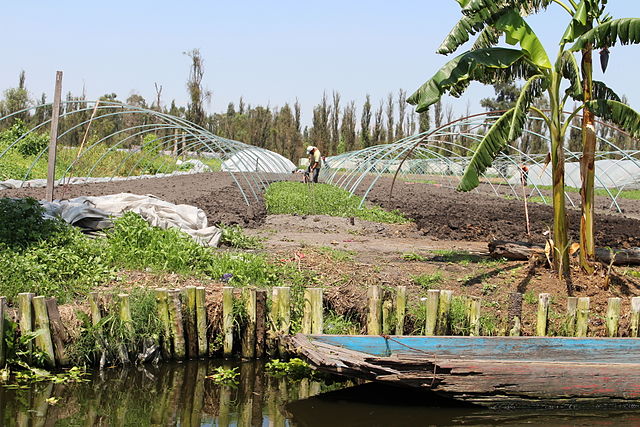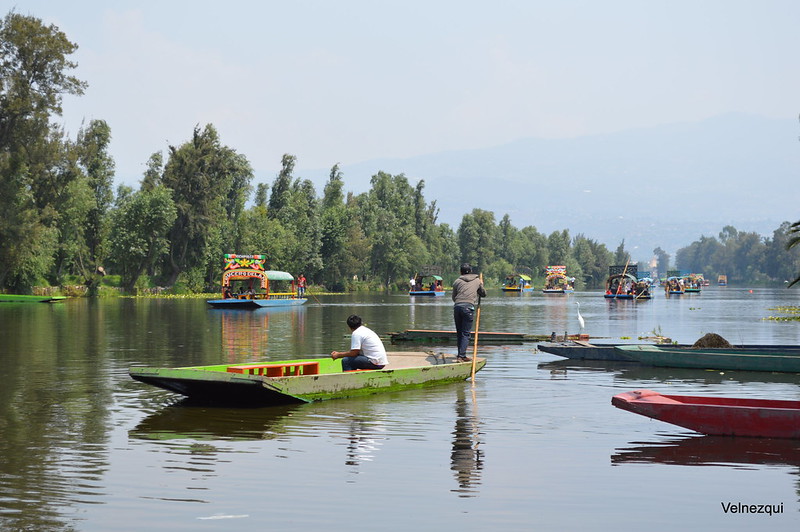Mexico City revives Aztec ‘floating farms’ to boost food supply after COVID-19 disruption
With COVID-19 unsettling supply chains, Mexicans are reviving indigenous farming methods pioneered by their pre-Colombian forebears 700 years ago.
I n coronavirus-hit Mexico City, local growers are turning to an ancient Aztec farming technique to meet demand as ordinary supply chains falter. Chinampas – the picturesque water-based plots also known as “floating gardens” – were a mainstay of the region back when it was the Aztec capital, Tenochtitlan, described by Spanish settlers as the “Venice of the New World”. Now, these time-honoured methods are enjoying a new lease of life as the pandemic complicates daily life for the city’s 22 million-strong population.

A modern day Chinampas. Photo by Emmanuel Eslava – CC BY-SA 4.0
COVID-19 has hit Mexico hard – and there is every sign the situation will get worse. On 13 July, the nation overtook Italy to chart the fourth-highest number of fatalities, after the US, Brazil and the UK. And the official death toll has trebled since lockdown was relaxed on 1 June.
The nation’s gargantuan capital, meanwhile, with a struggling public health system, poverty, crowded slums and a lack of running water provides an ideal haven for a runaway pathogen.
COVID-19 adds to a list of problems the nation was already facing thanks to climate change. In 2011, Mexico faced its worst drought in recorded history, which killed 1.7 million cattle, along with 2.2 million acres of crops. At current rates of global heating, Mexico could face a 40-70% decline in cropland by 2030. In a worst-case scenario, the entire country could be unfarmable by 2100.
Mexico City itself, meanwhile, swelters under a spiraling pollution problem. An arcane water system means that – despite having more rainy days than London – the capital suffers from chronic water shortages, with a fifth of residents having to wait days for just one or two hours of supply. Others in poorer districts are entirely dependent on delivery by truck. Many of these citizens also depend on the vast open-air produce market of La Central de Abasto – the largest in Latin America – which handles 30,000 tons of food and drink daily, representing 80% of consumption in the greater Mexico City area. But this mainstay for city’s poor has been hit by pandemic problems of its own, with warehouse and road closures causing shortages and driving up prices.

Over 22 million people live in Mexico City. Photo by Rodrigo de la torre from Pixabay
A new solution with an old heritage
Step forward the chinampa farmers of Xochimilco. In this waterlogged region in the city’s far south, farmers have clung on to indigenous farming methods that date back as far as the 14th century. Prior to the pandemic, the floating gardens mainly drew tourists, hoping to experience a whiff of the region’s pre-Colombian past on its pretty painted barges. Thanks to the crisis, however, the chinampas are once more in demand for their original purpose: providing vital sustenance to the urban population. The chinamperos have adopted a community-supported agriculture model of selling direct to consumers, and seen demand soar by 100 -120% between February and May.
The word chinampa comes from the Nahuatl term chinámitl, meaning a hedge or fence made out of reeds. Despite their eye-catching name, the floating gardens don’t actually float. They are created by scraping nitrogen-rich mud and vegetation from the bottom of a canal or swamp and piling it inside a border of reeds to create a new, usually rectangular, plot of farmable land. The corners are marked by ahuejotes, a local fast-growing willow that protects the chinampa from wind and acts as a trellis for vine plants.

Chinampa farmers have clung on to indigenous farming methods that date back as far as the 14th century. Photo by yeskefo/ Flickr
The capillary action of the root systems draws up water from the surrounding wetlands, which means the chinampas require minimal irrigation, and yet can yield as many as seven harvests a year – making them one of the most efficient farming systems on the planet. Xochimilco’s chinampas grow greens, legumes, tomato, pepper, corns, beans and squash as well as herbs and flowers. They can even be used for small-scale animal husbandry. Farmers navigate between plots using trajineras – traditional, flat-bottomed river boats.
In 2018, the FAO recognised chinampas as an Agricultural Heritage System of Global Importance. Despite this, it was long thought that runaway urbanisation spelled the end for the chinampas, with only 3% of the original 5,000 acres still in use for farming. Now, according to research associate Roland Ebel of Montana State University, the historic floating gardens could have a value beyond mere curios for tourists – and even beyond Mexico itself, as the megacities of the future adapt to the triple challenges of soaring populations, scarce land and rising seas.
Floating parcels of arable land
“Today, many cities face very similar challenges as Mexico City did 700 years ago – a rapidly growing population, and less and less arable land available for food production,” Ebel says. By 2050, the UN estimates that 68% of the Earth’s 10bn-strong population will live in cities. Ebel points to the Rhone River Delta in France, the Elbe in Hamburg and the Gulf of Finland as sites that could benefit from chinampas’ combination of sustainability, productivity, carbon capture and minimal resource requirements. “Wherever you have freshwater lakes near a big city, chinampa-like systems are conceivable – and this applies for many parts of the world,” he says.
There are reports of chinampas – or “raised fields”, as they are known elsewhere – being trialled as far away as Indonesia. But the world’s growers have found other, equally ingenious ways to eke productivity out of waterlogged environments. In low-lying Bangladesh, farmers traditionally continue to plant during the monsoon floods by assembling rafts from water hyacinths and aquatic weeds, which they anchor with bamboo rods to stop them floating away. Soil and manure are placed on top of the raft, which can be used to grow tomatoes, aubergines, chillies, spinach, beans and pumpkins in an environment free of fertilisers or pesticides, before the remains of the raft are used as beds for winter crops.
Meanwhile in the Netherlands, the Dutch property company Beladon opened the world’s first waterborne dairy farm in August 2018 in the teeming port of Rotterdam. The “Floating Farm” is designed to test whether small-scale dairy farming can flourish in one of Europe’s busiest, most urbanised areas, reducing food miles and transport pollution for city consumers.
The split-level facility harvests rainwater on the roof and processes milk and manure on the lower deck, which also houses a visitor gallery and shop. Cows are fed with grass from local playing fields and golf courses, along with waste products from Rotterdam’s food industry. They can take regular breaks from sea life on a quayside pasture. As of October 2019, the farm was home to 32 animals producing dairy items for sale on-site and in Lidl stores across the city.
The Floating Farm is a novel way of answering the same dilemma the Aztecs faced 700 years ago in their glittering New World Venice. How do we feed a growing population when land is at a premium? As the Floating Farm’s Minke van Wingerden put it: “Seventy percent of the world is water, so why not use the water to produce fresh, healthy food near to the consumers?”
The ideas presented in this article aim to inspire adaptation action – they are the views of the author and do not necessarily reflect those of the Global Center on Adaptation.